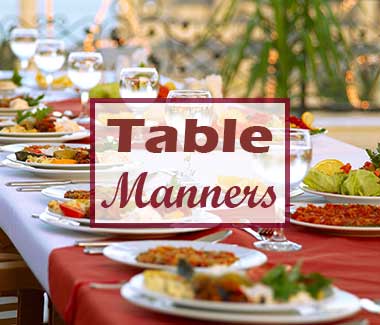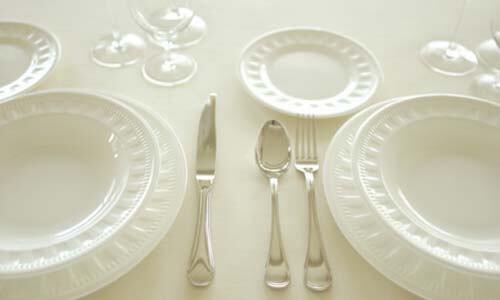Hong Kong Dining Etiquette
international dining etiquette
Note: The special status territory of Hong Kong shares essentially the same cultural traditions as mainland China.
Table Manners
You will most likely be seated at a round table with food for each course presented in the middle of the table. Depending upon the situation, either your host or a server will serve you each course, with either a large spoon, a set of chopsticks used exclusively for serving, or the opposite end of the chopsticks he is using to eat.
Dining etiquette for napkins. Instead of receiving a napkin to use throughout the meal, Hong Kong etiquette dictates that you receive a hot towel both before and after the meal. It is appropriate for you to use this towel for your hands and your face.
Dining etiquette for eating fish. When fish is served, notice that it will be placed on the table with the fish head facing the guest of honor. This part of the fish is considered quite a delicacy. If you are the guest of honor, you should not move it, but keep it in the position in which it is served to you. If you turn it over, that will be considered bad table manners. Rather than deboning the fish yourself, allow either your host or your server to debone it for you.
Dining etiquette for toothpicks. It is acceptable to use toothpicks between courses to dislodge food from your teeth and to pick up food that may be a challenge when using chopsticks.
Dining etiquette for rice. Take the bowl to your lips and then use your chopsticks to "shovel" the rice into your mouth.
You should leave something on your plate at the end of each course. This will demonstrate that you were satisfied with that course. (If you act as though you are a member of the "Clean Plate Club" by finishing everything, it may be interpreted that you did not receive enough.)
Dining etiquette for bones. It is acceptable to put fish or chicken bones or the like directly on the tablecloth rather than on an available plate, unless a special plate has been provided to you for discarded bones.
Dining etiquette for the end of the meal. You will know that the meal is nearing an end when you are served fried rice or noodles. It is served for mere form and it is considered appropriate not to touch this course. If you do, it may be misconstrued that the other courses have not satisfied you. Other ways to know that the meal is nearing an end is when a server places flowers in the middle of the lazy Susan, if fruit is served, and/or if you are handed a finger towel.
Dining etiquette for paying the bill. Whoever extends the invitation picks up the bill.
Chopstick Dining Etiquette
Place your chopsticks on the rest provided to you when you are not using them.
Do not point with your chopsticks.
Do not lay your chopsticks across each other because it is thought to bring bad luck.
Do not Stick your chopsticks in your rice bowl standing straight up.
Dining etiquette for seating. Whether you are in a meeting or at a banquet or similar setting, proper seating etiquette should be observed. The seat of honor is the center seat facing the door. The host is seated directly across from the guest of honor, with his or her back to the door. If you are offered the seat of honor, make a gesture or say a word or two to indicate that you are declining the honor. By doing this, you will be perceived as displaying your unworthiness for this honored seat. Immediately accepting it would be perceived as arrogant.
Dining etiquette for drinking tea. When you are in a meeting-like setting, you will most likely be served tea. Don't drink it immediately, but wait for the most senior host to take the first sip. Apart from being a refreshment, tea being sipped by a host can be a cue that a meeting is going well. The host not sipping tea can also serve as a cue that the meeting is about to end.
The sign language for requesting more tea is to either open the lid of the teapot or place the unattached lid on the table upside down.
If tea has just been served to someone and the person receiving the tea taps the table with three fingers of one hand, this is a gesture to thank the server.
Refill other people's teacups. Just as Westerners meet one another for coffee, taking tea in Hong Kong is a way of life as a social activity. Tea is even used to cure ailments. If you are invited to yum eha, you have been invited to have morning or afternoon tea. When taking part in a yum eha, you may notice a lot of finger tapping. This is a lovely ritual that began with an emperor of a Qing Dynasty. One day, when this emperor was visiting South China on an "incognito" inspection, he was having tea with others. When it was his tum to pour the tea, he realized he would reveal his royal status if he didn't pour, so he did it like any commoner. Those who knew him wanted to kneel to thank him, but since this would give away his identity, he asked them instead to tap their index finger and two center fingers on the table. This gesture was meant to signify the bow that they would normally extend to him in his role of emperor. Thus, this finger tapping ritual should be followed anytime tea is served to you as a gesture of appreciation to your host, guest, or server.
Dining etiquette for tipping. Tipping is more common in Hong Kong than in many other Asian countries. When paying a bill at a restaurant, keep in mind that most restaurants add a service charge. However, it is appropriate to add an additional 5 to 10 percent if the service has been outstanding.
Dining etiquette for toasting. While you may not be fluent in Cantonese, you certainly can establish rapport by knowing how to toast the proper way. While most Hong Kong Chinese understand English, it will be very much appreciated if you integrate one of the following phrases into your toasts, based on the situation:
For "Cheers," say "Yum boui"
If you would like to challenge another to consume the entire beverage, say "Yum sing."
When you are being toasted, don't feel compelled to drink the entire beverage, especially if it is the second or third alcoholic beverage served to you.
Whether you're the host or the guest, you should be prepared to make a toast. In fact, guests are expected to make toasts. Take your cue from those hosting the meal. If others stand when a toast is made, you should stand, too.



